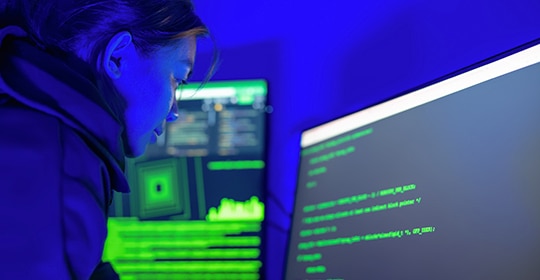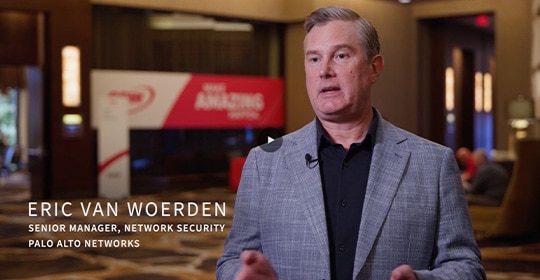Research everything IT
Showing results for: "security"
1 - 24 of 355
Sort By:
View:
Dec 29, 2025
AI | Emerging Tech
From Playbook to Protection: Making Data a Strategic Advantage
Article
6 min
Most organizations use only 30% of their data. Learn why robust data protection is critical for AI-driven innovation and how to turn untapped data into a strategic advantage.
Dec 23, 2025
Security
How Businesses Can Enhance Security and Deployments in Multi-OS Environments
Use Case
3 min
Discover how CDW helped a leading financial services company optimize device performance and streamline deployments within a mixed Windows and Mac ecosystem.
Dec 23, 2025
Services
Balancing Productivity and Protection — A Guide to Modern Workplace Security
Article
6 min
Learn how to balance productivity with security in the AI era. Discover best practices for governance, zero trust and safe workplace modernization.
Dec 17, 2025
Security
How Businesses Can Enhance Security for Legacy Applications
Case Study
3 min
Discover how CDW helped a rural insurance provider modernize access for a legacy application that lacked support for current authentication methods.
Dec 12, 2025
Security
Security in 2026: 4 Trends to Watch
Video
3 min
As AI transforms cybersecurity, organizations must be ready to adapt.
Dec 09, 2025
Digital Workspace
How To Modernize Your Customer Contact Center To Meet Evolving Expectations
Article
5 min
AI-enhanced platforms, customer contact centers are rapidly evolving to make agents more productive and to provide a seamless customer experience.
Dec 08, 2025
Services
Why Security Success Isn’t About Features, It’s About Execution
Article
4 min
Explore why cybersecurity success depends on effective execution, not just features. Learn how tailored deployment, optimization and integration drive ROI, and how CDW Managed Security Services maximizes value from your security investments.
Dec 05, 2025
Security
EDUCAUSE 2025: Higher Ed Strengthens Incident Response With AI and Practice
Video
1 min
At EDUCAUSE 2025, CDW experts shared how higher education leaders can modernize security operations, use artificial intelligence-driven forensics and make tabletop services routine to build faster, smarter incident response strategies.
Dec 04, 2025
Security
3 Tiers of a Framework for Mitigating Human Error
Article
4 min
To protect against cyber vulnerabilities caused by human behavior, organizations need visibility and control at the user level.
Nov 26, 2025
Services
4 Critical Security Considerations for AI in Higher Education
Article
5 min
AI tools like Gemini are transforming higher education, but they also introduce new risks. Learn the top four security considerations for CISOs and CIOs and how CDW helps institutions secure AI environments and strengthen domain security.
Nov 19, 2025
Security
Measuring the True Success of Your Vulnerability Management Program
Article
6 min
Are your vulnerability management efforts truly reducing risk or simply checking boxes? Learn to measure the success of your vulnerability management program with a tiered approach to metrics for operational, tactical and strategic insights.
Nov 06, 2025
Software
Copilot+ PCs with Windows 11 Pro: The Platform for Hybrid AI Innovation
Article
4 min
On-device neural processing units and integrated security help organizations customize and accelerate artificial intelligence initiatives.
Nov 05, 2025
Digital Workspace
How Nonprofits Can Overcome Year-End Fundraising Challenges With IT Solutions
Article
4 min
Discover how nonprofits can tackle year-end fundraising with strategic IT solutions. From cloud collaboration to data security, learn actionable steps to streamline operations, deepen donor engagement and drive mission success during Q4.
Oct 31, 2025
Hardware
Don’t Get Haunted by Ghost Devices: The Real Risks Behind Non-Genuine Windows
Article
4 min
Protect your IT environment from ghost devices and pirate software. Learn how genuine Windows 11 Pro ensures security, compliance and peace of mind with trusted deployment from CDW and advanced features.
Oct 30, 2025
Security
Secure the Unseen: Cracking the Code on Machine Identity Management
Article
5 min
Machine identities drive digital transformation but can pose security risks if left unmanaged. Effective management begins with a strong governance strategy, extending traditional IAM principles to address the unique challenges of machine identities.
Oct 29, 2025
Security
5 Affordable Ways to Boost Cybersecurity Maturity in Higher Ed
Article
5 min
Discover affordable strategies to strengthen your cybersecurity maturity. Learn how a trusted IT partner can help institutions secure data and modernize operations without overspending.
Oct 29, 2025
Cloud
5 Virtualization Options for State and Local Governments
Article
4 min
Virtualization solutions are evolving to improve flexibility, security and scalability. Find out how these technologies are helping public sector agencies modernize infrastructure and boost efficiency.
Oct 17, 2025
Data Analytics
CDW Executive SummIT: Key Strategies To Strengthen Your IT Environment
Video
4 min
As organizations generate and leverage more data, the need for a holistic security strategy has never been greater.
Oct 03, 2025
Hardware
Intel Copilot+ PCs with Windows 11 Deliver Unparalleled Performance and Security
Article
3 min
For IT teams, Intel vPro’s out-of-band manageability allows for efficient remediation and improved disaster recovery capabilities.
Oct 02, 2025
Cloud
How the VMware Acquisition Has Affected the Public Sector
Article
4 min
Agencies dealing with major changes in their hypervisor software should consider a move to the cloud.
Oct 01, 2025
Cloud
Why Healthcare CIOs Must Prioritize Foundational Tech Investments
Article
4 min
Discover why healthcare CIOs must prioritize foundational tech like cloud, cybersecurity and data analytics to tackle rising patient demand, improve efficiency and manage costs effectively. Learn actionable strategies to align tech with critical goal
Sep 30, 2025
Digital Workspace
New CDW Research: How Organizations Optimize the Digital Experience
White Paper
14 min
The modern workplace requires organizations to deliver an excellent user experience while overcoming challenges related to security and integration.
Sep 30, 2025
Security
Acronis Cyber Protect: A Unified Solution for Cybersecurity and Data Protection
Article
2 min
Discover how Acronis Cyber Protect empowers small- and medium-sized businesses with integrated cybersecurity, data protection and endpoint management. Learn about its benefits, industries served and technical requirements.
Sep 30, 2025
Security
The Benefits of Modernizing Your Physical Security Infrastructure
White Paper
13 min
By upgrading and integrating systems such as video surveillance, access control and identity management, organizations can take a proactive approach to security.























